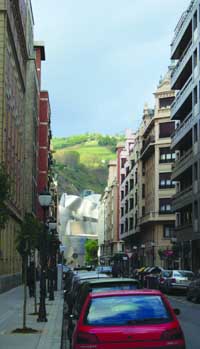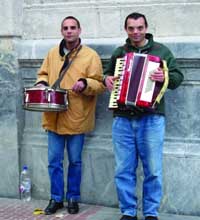|
 IKE
THOUSANDS of visitors before me, I enjoyed Barcelona’s
Belle Époque architecture (Gaudi in particular) and Madrid’s
Prado museum and vibrant Rastro Sunday Market. However, there was
something about Spain’s Basque region that struck a chord within
me that went deeper than the sensory pleasures of a European escape. IKE
THOUSANDS of visitors before me, I enjoyed Barcelona’s
Belle Époque architecture (Gaudi in particular) and Madrid’s
Prado museum and vibrant Rastro Sunday Market. However, there was
something about Spain’s Basque region that struck a chord within
me that went deeper than the sensory pleasures of a European escape.
In the process of changing careers in my mid-30s
from corporate (public relations) to creative (teaching and writing),
I realized I wasn’t so much reinventing myself as I was taking
the best parts of my past and mixing it with new ideas to charge
off in a fresh direction for the new century. For this reason, a
journey to Bilbao and its neighbouring cities wasn’t so much
a mere pleasure trip as it was a source of inspiration and affirmation
that all it takes is some ingenuity and will to move toward a better,
more beautiful future.
Though the Basque region has been known for a
variety of things, ranging from its popular Rioja wines to internal
conflict between Basque and Spanish nationals, fateful watershed
events like the pre-World War II German attack on the town of Guernica,
and other historic challenges imposed on its unique identity, the
cities and towns of this province in the north central corner of
Spain serve as textbook examples of civic pride genuinely working
wonders. The romantic, multi-level city of Vitoria-Gasteiz is not
only filled with idyllic ambiance but also one of the highest standards
of living in western Europe. In villages like Berneo, Mundeka (getting
increasingly popular as an international destination for surfers
with its popular Bakio Beach) and Getaria (future home of the Balenciaga
Museum), treasured Spanish and Basque customs seem to coexist seamlessly
with young people building their futures and introducing modern
lifestyle elements to the mix—and in a most impressive, environmentally
conscious way.
David Elexgaray, my guide, points out that the
Basque country is a biosphere. After registering what must have
been my quizzical expression, he further explains that it is biosphere
not in the closed-off, clinical sense Americans are familiar with,
but in a wide open sense with the convergence of culture and nature.
‘The cities grew up on river estuaries, and
the way they are developing now in terms of how people are using
and protecting the natural resources and how those resources shape
the people,’ he tells me. ‘Bilbao itself was an industrial
city affected by some ETA (radical
Basque political movement) violence, political turmoil, and the
Asian tech boom, which ultimately plunged the area into a crisis
economically and identity-wise in the 1970s and 1980s. City planners
and residents alike, however, decided to take stock in and learn
from their setbacks, first by finding ways to politically and culturally
embrace the dual Spanish and Basque heritages, then by making a
commitment to take better care of the environment and then taking
a stand in favour of a technological shift and increase in the number
of cultural institutions. Emphasis on quality rather than quantity
helped the region overcome the push from the Far East. While the
cost of living has risen with the standard of living, some young
people are moving to the other cities and towns, and really taking
good care of their homes and the areas which surround it.’
While young families are raising their children
in such peaceful, old world settings of Mundeka and Gexto and older
people are living out their days with contentment, the new-and-improved
Bilbao is a vibrant, modern walking city in every sense. While the
Guggenheim (opened in 1997) is the epicentre of the city’s
revitalization, there is an abundance of small squares, parks and
waterfront walkways which keep its soul rooted in the more genteel
aspects of its past. I took note of the city’s many bridges
old and new, which I found most symbolic—the new and the old
at last coming together harmoniously. I am quite taken with this
renaissance city, which according to David, began the heart of its
magnificent transition only four or five years ago.
On the first night, me and my travel companions
were routed by our locals-in-the-know to Casa Rufo (Hurtado de Amezaga,
5), a festive, casual restaurant experience with old world flair,
where tables are nonchalantly set up among deli counters and dry
goods. The food was generous and hearty, as were the owners and
the in-house cook, who spends his time smoking meats when he is
not preparing his simple, but awe inspiring steaks, fish, croquetas
and roasted vegetables, accented with lots of crusty bread and good
humour.
However, outside the classic 1900s ambiance of
Casa Rufo and various pinxtos (say, ‘pinchos’,
the regional term for tapas) bars nestled in the city’s gothic
quarter’s plaza (Casa Victor Montes, Berton, La Almacena),
was a world that very much is in the moment of the 21st century.
On quaint and diagonal streets sporting accents of Madrid, Paris
and London are hip boutiques and chain stores, and lots of young,
fashionable professionals and college students with a palpable sense
of enthusiasm and optimism. The storefronts were artistically rendered
with carefully executed modern displays of furnishings and clothes
that provide a nice sense of contrast to old-style delicatessens,
bakeries and food shops.
Though home décor stores are as abundant
as fashion stores, old traditions are also alive and dynamic in
the city setting, from the friendly mature Basque gentlemen wearing
berets and offering directions and colourful stories to small children
playing in the idyllic settings of green, manicured city parks and
buildings dating from the middle ages to the renaissance to the
present. Other Basque destinations that simultaneously exemplified
the combined reverence and respect for the past and the present
included Guernica’s Peace Museum and the Museu Chilleda (in
Hernani, not far from Donostia–San Sebastian, uniting a dignified
and simple university town with one of Europe’s great playgrounds
for the affluent) which in their own ways encourage people to ponder
history and ways they could build a better future. While historical
artifacts and recreations abounded at the Peace Museum, Chilleda’s
highly-tangible contemporary sculptures surround and fill a 1592
farm house with the same sentiment David described with the region’s
concept of the biosphere.
On the riverfront, rising like flowers from a
vase created by the surrounding downtown area is the Frank Gehry-designed
Guggenheim Bilbao, its accenting outdoor sculptures along with an
impressive array of new hotels (like our temporary residence at
the well-appointed Sheraton Bilbao), cultural buildings and other
civic projects that make it hard to believe that just a decade ago,
Bilbao was primarily industrial. Gexto, the quaint British-looking
town where Bilbao’s industrialist wealthy summered in the Victorian
area, was a living showcase for the Punete Colgante, a hanging bridge
marking the region’s move into a modern era more than a century
ago. Frank Gehry’s Guggenheim Museum, in turn, was the watershed
project in this age that started the process of making Bilbao and
the Basque country what it is today … one of the most desirable
places to live in Europe and a “best kept secret” that
won’t remain so for much longer.
Although the Guggenheim Bilbao is home to lots
of symbolic works from Liechtenstein, Rosenquist and Jenny Hauser,
it was an imposing spider sculpture created by French artist Rose
Bourgeois that summed up the spirit of the modern Basque country
through her metaphor—that we, as individuals and collectively,
have the ability to weave our own destiny. •
|
A journey to Bilbao wasn’t
so much a mere pleasure as it was a source of inspiration and affirmation
that all it takes is some ingenuity and will to move toward a better,
more beautiful future




|
Where fashion in Spain reigns
|
For more information on the Basque Country and other
fantastic destinations in Spain, contact the Tourist Office
of Spain at www.okspain.org or
www.spain.info, with offices
in Miami, Los Angeles and Chicago.
Elyse Glickman is a regular correspondent
to Lucire.
|

